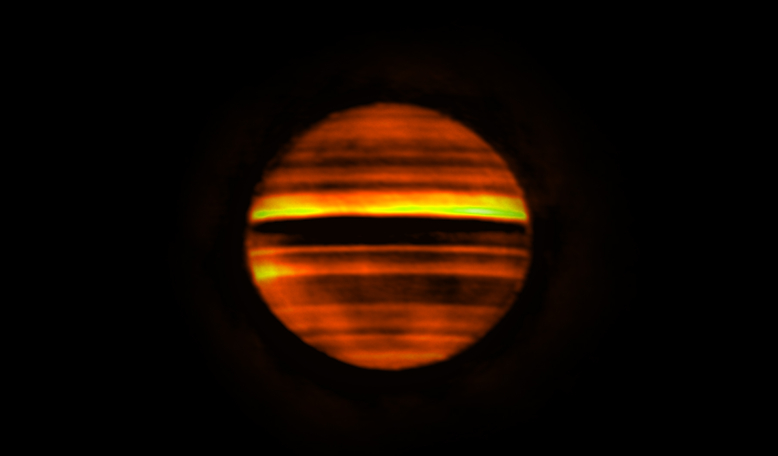Beneath the swirling skies of Jupiter, a storm is brewing. In fact there is always a storm brewing on the Solar System’s biggest planet; one that while spectacular to see, could strip the spacesuit from your skin with its toxic composition. How do we know this? Scientists using ALMA have been able to peer deep into the gas giant’s atmosphere to reveal for the first time what makes up the atmosphere below Jupiter’s uppermost ammonia cloud layers - and it’s more ammonia.
The big and beautiful belts that wrap around Jupiter are some of the most spectacular sights to see in our cosmic backyard, using nothing more than the light your eyes have evolved to see - visible light.
But to look at what is going on below the maelstroms that churn through Jupiter’s atmosphere, astronomers need more; more light but of a different wavelength. This is where ALMA comes in. ALMA is able to capture radiation from space from a few hundred micrometers to approximately one millimetre (close to one thousand times longer than visible light waves); perfect for peeking through cloud layers that otherwise block the underlying light from coming through.
This wide-ranging observation power enabled scientists working with the array to make a three-dimensional map of the distribution of ammonia gas below the clouds. “For the first time, we were able to study the atmosphere below the ammonia cloud layers after an energetic eruption on Jupiter,” said Imke de Pater of the University of California, Berkeley.
The eruption was caused by a plume – a small bright cloud that marks the presence of a storm – breaking through the layered atmosphere and it was spotted by amateur astronomers occurring in Jupiter’s South Equatorial Belt in January 2017. After it reached the surface, it caused large-scale disruption in the belt that lasted for weeks, giving astronomers the chance to study the atmosphere below the plume with ALMA.
What they found, is that below the top-most ammonia ice cloud layer, is a layer of solid ammonia hydrosulfide particles. Ammonia hydrosulfide on Earth is a combustible material that when applied in a solution can be used to colour brasses and bronzes. It is a very corrosive substance that can cause severe burns to the skin and eyes if you come into contact with it. But ammonia hydrosulfide also comes in handy if you have taken some stunning pictures of Jupiters storms as it can also be used to develop photographs.
Deeper still, around 80 kilometres below the upper cloud deck, astronomers studying the ALMA data found that there is likely a layer of liquid water. “Our ALMA observations are the first to show that high concentrations of ammonia gas are brought up during an energetic eruption,” said de Pater. “The combination of observations simultaneously at many different wavelengths enabled us to examine the eruption in detail.
This led us to confirm the current theory that energetic plumes are triggered by moist convection at the base of water clouds, which are located deep in the atmosphere. The plumes bring up ammonia gas from deep in the atmosphere to high altitudes, well above the main ammonia cloud deck,” she added.
After using ALMA to study the atmosphere below the plume and the disrupted belt at radio wavelengths, De Pater and her colleagues then compared these to UV-visible light and infrared images made with other telescopes at approximately the same time.
“These ALMA maps at millimetre wavelengths complement the maps made with the National Science Foundation’s Very Large Array in centimetre wavelengths,” said Bryan Butler of the National Radio Astronomy Observatory. “Both maps probe below the cloud layers seen at optical wavelengths and show ammonia-rich gases rising into and forming the upper cloud layers (zones), and ammonia-poor air sinking down (belts).”
“The present results show superbly what can be achieved in planetary science when an object is studied with various observatories and at various wavelengths”. Explains Eric Villard, an ALMA astronomer part of the research team. “ALMA, with its unprecedented sensitivity and spectral resolution at radio wavelengths, worked together successfully with other major observatories around the world, to provide the data to allow a better understanding of the atmosphere of Jupiter.”











